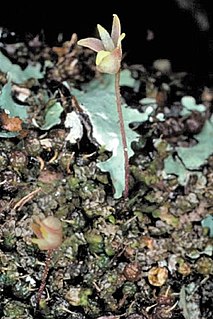
Bulbophyllum globuliforme, commonly known as the green bead orchid, miniature moss-orchid or hoop pine orchid, is a species of epiphytic orchid with tiny spherical pseudobulbs, scale-like leaves and small cream-coloured flowers with a yellow labellum. It grows on the scaly bark of hoop pine, mostly on the McPherson Range on the New South Wales/Queensland border in eastern Australia. Because of its small size it is often dismissed as moss.
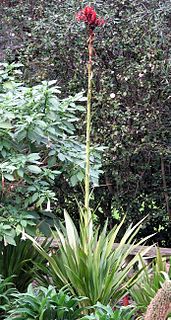
Doryanthes excelsa, commonly known as the gymea lily, is a flowering plant in the family Doryanthaceae that is endemic to coastal areas of New South Wales near Sydney. It has sword-like leaves more than 1 metre (3 ft) long and it grows a flower spike up to 6 metres (20 ft) high. The apex of the spike bears a large cluster of bright red flowers, each 10 centimetres (4 in) across. Its common name is derived from the name given to the plant by the indigenous Eora people. The Sydney suburbs of Gymea and Gymea Bay are named after the lily.
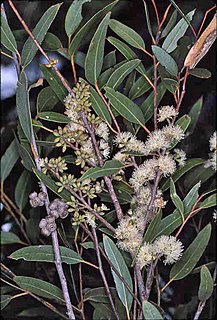
Eucalyptus globoidea, commonly known as the white stringybark, is a tree that is endemic to near-coastal areas of south-eastern Australia. It has rough, stringy bark, often furrowed on the trunk, glossy, lance-shaped to egg-shaped, often curved leaves, oval to spindle-shaped green to yellowish flower buds, white flowers and small, more or less spherical to hemispherical fruit.

Melaleuca squarrosa, commonly known as scented paperbark, is a plant in the myrtle family, Myrtaceae and is endemic to south eastern parts of Australia, especially Tasmania. It is an attractive shrub with dense foliage and arching branches and it flowers profusely in spring or early summer, bearing spikes of perfumed yellow to white flowers.

Rimacola elliptica, commonly known as the green rock orchid or green beaks, is the only species of plant in the orchid genus Rimacola and is endemic to New South Wales. It is an evergreen species which grows in clumps in sandstone cracks and has bright green leaves and in late spring, produces arching flower stems with up to eighteen dull greenish flowers with reddish or brown markings. It only grows near Sydney, mainly in the Blue Mountains and near Fitzroy Falls.
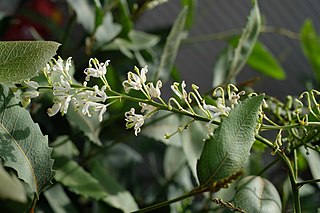
Lomatia ilicifolia, commonly known as holly lomatia or native holly, is a plant in the family Proteaceae and is endemic to south-eastern Australia. It is a stiff, erect shrub with hairy, rust-coloured new growth and which recovers from fire from a lignotuber. It has dull green, leathery, prickly, holly-like leaves and long sprays of cream flowers, usually after fire.

Dendrobium aemulum, commonly known as the ironbark feather orchid or white feather orchid, is an epiphytic orchid in the family Orchidaceae and grows on trees that retain their bark, especially ironbarks. It has reddish or purplish pseudobulbs, two to four leathery leaves and up to seven white, feathery flowers. It grows in open forest in Queensland and New South Wales.

Melaleuca flammea, commonly known as tapering-leaved bottlebrush, is a plant in the myrtle family, Myrtaceae and is endemic to New South Wales and Queensland in Australia. It is a shrub with broad, lance-shaped leaves which have wavy edges and taper gradually to a fine point. In spring it has typical bottlebrush flowers whose fiery colour gives the species its name.

Pleurophascum grandiglobum is a moss endemic to Tasmania, Australia, and was first noted by S. O. Lindberg in 1875 for its peculiar form of cleistocarpous capsule, erect growth form, lateral perichaetia, and ecostate leaves. Its exceedingly large, inoperculate, and often brightly coloured capsules captured the heart of the 19th-century Scandinavian bryologist, who considered the moss to be "of no less interest to the Muscologist than is Rafflesia or Welwitschia to the Phanerogamist". The species currently belongs to a monogeneric family Pleurophascaceae that is found only in temperate Australasia and includes three different species. Pleurophascum ovalifolium, heretofore known as P. grandiglobum var. decurrens, is the New Zealand taxon while the last remaining member of the genus, Pleurophascum occidentale, occurs only in Western Australia.
Bartramia is a genus of mosses in the family Bartramiaceae. The genus was first formally described by Johann Hedwig in 1801. There are about 72 species, usually growing on soil, sometimes on rocks, in many habitats in many parts of the world, although tropical species are only found at high altitudes. Nine species occur in Australia but only three of these are endemic to that continent.

Pterostylis bicolor, commonly known as the black-tip greenhood, is a plant in the orchid family Orchidaceae and is endemic to south-eastern Australia. It has a rosette of leaves and when flowering, three to ten well-spaced, bright green flowers with a blunt, greenish-black appendage on the labellum. It is similar to the swan orchid, Pterostylis cycnocephala but that species has a beak-like appendage and crowded flowers.

Pterostylis hamata, commonly known as the southern hooked rustyhood, is a plant in the orchid family Orchidaceae and is endemic to eastern Australia. It has a rosette of leaves and between two and twelve transparent flowers with green and brown markings, a thick, brown, insect-like labellum and dished lateral sepals.

Pterostylis laxa, commonly known as the antelope greenhood, is a species of orchid endemic to south-eastern Australia. As with similar greenhoods, the flowering plants differ from those which are not flowering. The non-flowering plants have a rosette of leaves flat on the ground but the flowering plants have a single flower with leaves on the flowering spike. This greenhood has green and white flowers with darker green or brown markings and a dorsal sepal with a long thread-like tip.
Pterostylis bicornis, commonly known as the horned greenhood, is a plant in the orchid family Orchidaceae and is endemic to eastern Australia. Non-flowering plants have a rosette of leaves while flowering plants have a similar rosette at the base of a flowering spike with a one or two dark green, white and brown flowers. The flowers have distinctive long, thin horn-like tips.
Pterostylis bryophila, commonly known as the Hindmarsh Valley greenhood, is a species of orchid endemic to South Australia. As with similar greenhoods, plants in flower differ from those that are not. In this species, plants not in flower have a rosette of leaves lying flat on the ground, but those in flower have a single small, shiny, bright green and white flower with a protruding, platform-like sinus between the lateral sepals.
Pterostylis excelsa, commonly known as the tall rustyhood, or dry land green-hood is a plant in the orchid family Orchidaceae and is endemic to South Australia. It has a rosette of leaves and when flowering, up to twenty green or brown flowers which lean forward and have a thick, fleshy, partly hairy, insect-like labellum.
Pterostylis gibbosa, commonly known as the Illawarra rustyhood, or Illawarra greenhood, is a plant in the orchid family Orchidaceae and is endemic to New South Wales. It has a rosette of leaves at its base and up to nine bright green flowers with translucent "windows", relatively wide lateral sepals with short-pointed tips and a dark, fleshy, insect-like labellum.

Pterostylis pusilla, commonly known as the tiny rustyhood is a plant in the orchid family Orchidaceae and is endemic to southern Australia. It has a rosette of leaves and up to nine relatively small green and reddish-brown flowers with translucent white "windows" and a dark brown, insect-like labellum.
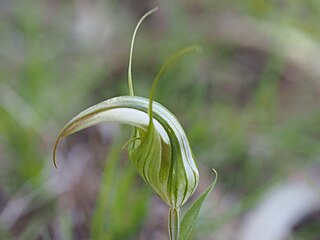
Pterostylis reflexa, commonly known as the dainty greenhood, is a species of orchid endemic to New South Wales. As with similar greenhoods, the flowering plants differ from those which are not flowering. The non-flowering plants have a rosette of leaves flat on the ground but the flowering plants have a single flower with leaves on the flowering stem. This greenhood has a relatively large white, green and light brown flower with a long, curved dorsal sepal and a protruding labellum.

Pterostylis rufa, commonly known as the red rustyhood is a plant in the orchid family Orchidaceae and is endemic to south-eastern Australia. It has a rosette of leaves and up to fifteen bright reddish-brown flowers with translucent white "windows" and a dark brown, insect-like labellum. It occurs from southern Queensland to south-eastern South Australia.





















